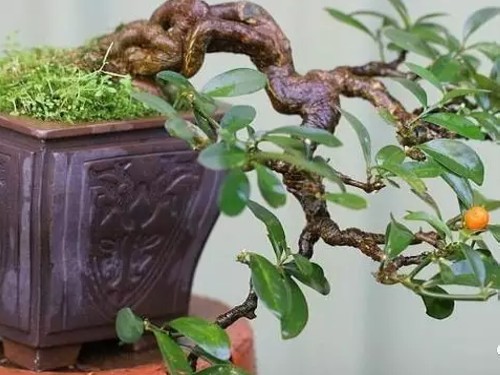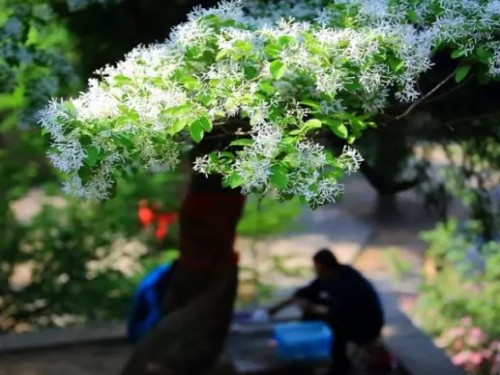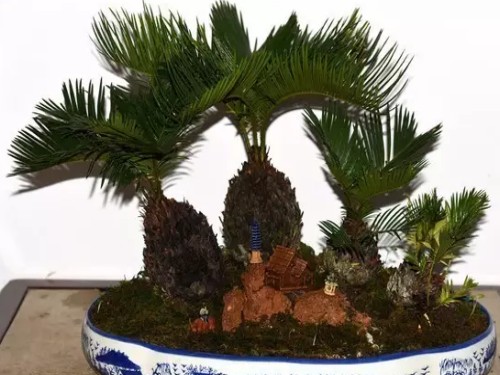The production of Golden Bean Bonsai
Golden bean and kumquat both belong to Rutaceae. Golden bean is the smallest variety of Rutaceae plants. It is a wild shrub native to Taizhou, Zhejiang Province. Golden beans are naturally strong, like slightly acid soil, like sunshine, like warm and humid environment. It is easy to be cultivated in the south of the Yangtze River. The golden bean plant is short, suitable for making bonsai, the flowers are fragrant, the fruit is fragrant, the fruit is long, the fruit is dark green in the early stage, turns yellow through winter, then turns orange, and the leaves do not wither through winter. New Year's Day's red fruit and green leaves are very beautiful during the Spring Festival.
Golden bean fruit golden, with fragrance, hanging fruit for a long time, is an excellent ornamental fruit flowers. It is suitable for potted plants and bonsai, at the same time, it tastes sour and sweet and delicious, and has many nutritional values. Potted kumquat is evergreen all the year round, with luxuriant branches and leaves and beautiful tree shape. It blossoms in summer, the color is jade white, and the aroma is overflowing. Autumn and winter fruit ripe or yellow or red, embellished in the green leaves, can be described as Biye Jinwan, help sparse Changrong, high ornamental value.

I. material selection and cultivation measures
1. Artificial propagation
Cuttings should be carried out from late May to late June, and cuttings should be selected from fully developed branches of the previous year, or shorter shoots of semi-lignified internodes of the same year. Cuttings about 10 cm long, remove the lower branches and leaves, leave two leaves at the upper end, and cut off half of each. Insert into the soil at a depth of about 23, compact the surrounding soil of Zhou B, fully water it, and keep the soil moist later. After insertion, a shed should be built in time for shade, and it should be sprayed frequently so that it can take root after about 30 days. After that, it is necessary to carefully maintain and manage, and then transplant and cultivate big seedlings after the next spring is warm.
Grafting can be carried out from early April to early May, often with splicing or splicing. If bud grafting is used, it can be carried out from June to September. Rootstocks are often used for citrus seedlings, as well as bergamot, lemon and tangerine. The cultivation method of the fruit of potted golden bean grafted in the same year:
Cuttings of bergamot or lemon were used to maintain sturdiness, and split grafting was used when the branches were semi-lignified from May to August. The scion should be bagged with sturdy branches that are semi-lignified in the same year, and then bagged after about 1 week. Leave 1 strong branch after survival, cut off the other grafted branches, and remove the rootstock buds at any time. After 20 days, remove the tie rope and strengthen the fertilizer and water management. The main fertilizer was phosphorus and potassium fertilizer, which was applied every 10 days. Pay attention to buckle the water and increase the light. If properly maintained, it can blossom and bear fruit in the same year.
Second, the process of potting.
It should be carried out in April in spring, and when the billet pile sends out new branches and leaves, it can be put on the pot as early as the second half of the year. If time permits, maintenance is generally required for more than 2 years. The most suitable time to change the basin is after Qingming Festival (April 5), and another more appropriate time is the end of August and the beginning of September.
Golden beans should use medium-deep purple sand pottery basin, glazed pottery basin can also be used. It is not suitable to use a shallow basin, the shape of the basin can be square, rectangular or round, and the basin color should be begonia red or deep sunflower yellow to set off green leaves and golden fruits to increase the ornamental effect.
The soil is required to be fertile, and some cake fertilizer and rotten leaf soil can be added appropriately. The acid sandy loam with good permeability is the most suitable for growth. Potted plants are often mixed with weathered pond soil or pastoral soil mixed with sand.
4. the method of potting.
Golden beans can be brought to the soil, or they can be put on the pot with bare roots. The root system should be arranged when planting, so that the fibrous root can be stretched in the basin soil, the old root should be cut off properly, and the broken bone, vegetable cake and bone powder should be used as base fertilizer at the bottom of the basin. When the bare root is in the basin, the overlong thick root can be properly truncated, which is helpful to promote the new root.
(1) Water and weed management
Water management is the same as common flowers and trees, dry to wet, dry to wet. Bonsai with golden beans are easy to die if they are too dry. Weeds need to be pulled out manually and herbicides should not be used as far as possible. A slightly higher concentration of herbicide will cause the death of golden bean.
(2) Fertilizer management
Plants that have just come into the pot should not be fertilized. Generally speaking, if the potted soil is fertile, it will no longer be used as topdressing. If the fertility of the basin soil is poor, some quick-acting compound fertilizer can be applied lightly as appropriate. In general, flowerpots with 25cm in diameter can be applied with more than 10 grains of compound fertilizer. The time of topdressing is before the sprouting of golden beans, and it is better during the Qingming Festival. Golden beans germinate at more than 25 ℃ and usually sprout at the beginning of May. The suitable number of topdressing is one time.
Third, orthopedic techniques
1. Processing
Golden beans are mostly processed by pruning and rarely climbing. Just clamp up the trunk and branches properly, and the rest can be trimmed. Processing and pruning should be carried out in April when it is overcast and rainy.
2. Tree shape
Golden bean shape should be simple to win, can not be too complicated, the main tree shape is straight dry type, oblique dry type and so on.
It is generally trimmed to a natural large tree or semicircular sphere.
IV. Maintenance and management
1. Place of placement
Golden beans like light, should be placed in a sunny, warm and ventilated place, summer should be appropriate shade, avoid exposure, the location should be fixed, should not move more. In full bloom, you should pay attention to avoid the rain, and it is appropriate to move indoors in winter to prevent freezing.
2. Watering
Usually keep the basin soil moist, spring growth period should be frequently watered, summer high temperature period, "buckle water" method can be used to inhibit summer shoot growth and promote flower bud differentiation.
3. Fertilization
Golden beans are good fertilizer, so it is appropriate to apply thin fertilizer frequently, mainly phosphorus and potassium fertilizer, such as chicken, duck manure or fishy water, once every 7 to 10 days. In the rainy season, you can sprinkle some cake fertilizer crumbs on the basin, apply little or no during flowering, and apply light fertilizer twice after the fruit is settled.
4. Pruning
It is usually carried out in early spring from February to March. Mainly cut off the withered and weak branches, overlapping branches, cross branches and disease and insect branches, according to the tree shape, we can adopt the principle of strong branches and weak branches to cut short the main branches, generally leaving 4-5 buds on the stout branches, 2-3 buds on the thin and weak branches, and cutting off the rest. After the new shoots germinate, the over-dense branches and twigs that disturb the tree shape should be removed as soon as possible.
5. Turn the basin
The golden bean can turn the basin every 2-3 years, and the time should be from March to April in spring. 12 old soil can be removed and replaced with loose and fertile culture soil, and some rotten roots and old roots can be cut off at the same time.
6. Pest control
The main diseases of golden beans are black mildew, which can be sprayed with Bordeaux liquid or wiped off with 5% alcohol; insect pests are mainly shell insects, which can be sprayed with 1000 times of omethoate or removed with a small brush or knife.
Time: 2019-05-26 Click:
- Prev

Tassel grafted osmanthus bonsai
Tassel, also known as April snow or shredded radish flowers, is in full bloom every early summer, covered with white flowers, such as frost and snow. Tassel flower, white and flawless, like a fairy who does not eat human smoke and fire, detached from the dust. Beautiful flowers, such as the ancient ladies dress tassel, hence the name, very beautiful, both elegant and holy
- Next

The method of making Iron Tree Bonsai
The iron tree, whose real name is Cycas, is a small evergreen tree of the genus Cycas of the Cycads family, and is a precious ancient relict plant. Cycads native to the mountains of Fujian are mainly cultivated in China. In recent years, Sichuan Panzhihua cycad, Yunnan cycad and so on, have also been introduced and cultivated in various places. Cycads are graceful in shape
Related
- Fuxing push coffee new agricultural production and marketing class: lack of small-scale processing plants
- Jujube rice field leisure farm deep ploughing Yilan for five years to create a space for organic food and play
- Nongyu Farm-A trial of organic papaya for brave women with advanced technology
- Four points for attention in the prevention and control of diseases and insect pests of edible fungi
- How to add nutrient solution to Edible Fungi
- Is there any good way to control edible fungus mites?
- Open Inoculation Technology of Edible Fungi
- Is there any clever way to use fertilizer for edible fungus in winter?
- What agents are used to kill the pathogens of edible fungi in the mushroom shed?
- Rapid drying of Edible Fungi

